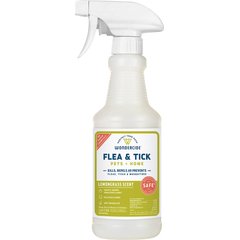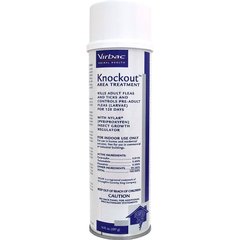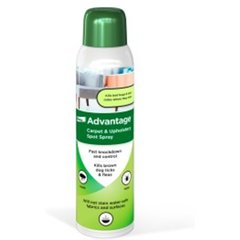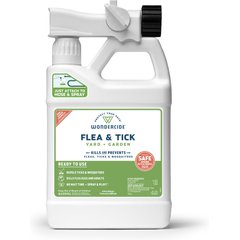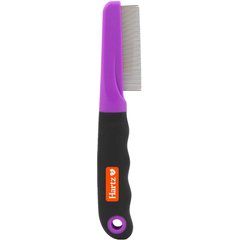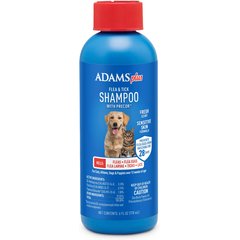How To Get Rid of a Flea Infestation
Adobe Stock/Pixel-Shot
At some point, you might see your pet itching like crazy due to flea allergy dermatitis, the allergic reaction caused by flea bites. Fleas can jump onto your pet when they’re outside or hitch a ride on objects brought indoors, such as clothes from a flea-infested area or a used pet bed. And once inside, fleas can move from your pet or these objects right onto you.
So even if your pet stays indoors, or you don't have pets at all, you could still end up spotting bites (and feeling their itch!) on your own skin. Either way, you’ve got a flea infestation, and you’ll want to take care of it—stat. Here’s how.
What Are Fleas?
Fleas are small, wingless parasites that feed on the blood of pets, humans, and other animals several times a day.
Barely measuring an eighth of an inch in length, fleas can jump as far as 13 inches—that’s about 100 times their body length! To make matters worse, a single female can lay roughly 50 eggs in a single day, according to David Gosche, DVM, a veterinarian at Elanco.
Fleas have a four-stage life cycle:
-
Egg
-
Larva
-
Pupa
-
Adult
Adult fleas lay eggs on their host, which can fall off and hatch in the environment. Dr. Gosche says flea life cycles can be as quick as two to three weeks, or fleas can lie in wait (in which case it could take months to get a severe flea infestation under control). When conditions are right, like warm weather or signs of a host (such as carbon dioxide from breathing), pupae emerge to continue their plight.
Fleas are more than just irritating. They can transmit diseases and parasites to people and their pets. For instance, tapeworms are spread by fleas. These tapeworms can be really disturbing for pet parents to see emerging from their pets, Dr. Gosche says.
Fleas also carry Bartonella bacteria, the culprit behind cat scratch disease in humans. In severe cases, flea infestations can cause anemia in kittens and puppies, according to Nikhil Joshi, VMD, a veterinarian at Merck Animal Health.
How To Detect Fleas on Your Pet
Fleas will bite and feed anywhere on pets, but the most common spots they bite are at the base of the tail and along the back.
Signs a pet has fleas include:
-
Itching
-
Gnawing and biting
-
Flea dirt (flea waste that looks like tiny, black, pepper-like specks)
-
Tapeworm segments (flat pieces that break off from an adult tapeworm) in stool or emerging from your pet’s rectum
-
Hair loss
-
Irritated or scabbing skin
How To Detect Fleas in Your Home
Fleas are more common in homes with pets, but it doesn't take having a pet to develop a flea infestation. Fleas could be lying dormant in a vacant apartment or hitch a ride from the outdoors into your home. Wildlife in your backyard like squirrels, raccoons, and feral cats can also carry fleas that can eventually make their way inside.
You may only see a few adult fleas at first or their bites. The hidden threats are the flea eggs, larvae, and pupae that are easy to miss.
Signs that your home has a flea infestation include:
-
Bites, particularly around the ankle
-
Spotting small, round flea eggs in carpet, furniture, and blankets
-
Flea dirt on bedding, floors, and socks
-
Visible fleas
The most common places to find fleas, their eggs, and waste in the home include:
-
Bedding
-
Blankets
-
Rugs
-
Carpeting
-
Upholstery
-
Pet beds
-
Cracks and gaps in flooring
-
Behind baseboards and molding
White Sock Test
A simple way to check if your house has fleas is to put on white socks and walk around the house, says David Price, associate certified entomologist and director of technical services at Mosquito Joe.
“Adult fleas are attracted to movement and warmth, so they will jump onto the socks,” he says.
While fleas on your socks might be the last thing you want, it’s a quick way to spot them due to the contrasting color.
Flea Dirt vs. Dirt
Not sure if you’ve spotted regular dirt or flea dirt? Grab a damp paper towel and put some flecks on it. Flea dirt turns reddish-brown when damp.
“Flea dirt is actually flea feces consisting of digested blood,” Joshi explains.
How To Get Rid of Fleas in Your Home
Now that you know the signs, have you spotted fleas in your home? Taking quick action now will prevent a full-blown flea infestation later.
Here’s how to get rid of a flea infestation.
In Your Bed
-
Wash all bedding (sheets, pillowcases, blankets) in hot, soapy water.
-
Dry the bedding on high heat.
-
Vacuum the mattress and surrounding areas thoroughly.
On Your Furniture
-
Vacuum upholstery thoroughly.
-
Use flea sprays designed for furniture.
-
Wash removable covers and cushions in hot soapy water. Dry on high heat.
-
Steam-clean furniture that cannot be washed.
Recommended Products
In Your Carpet and Rugs
-
Vacuum carpets and rugs at least twice a day, disposing of the vacuum bag or canister contents immediately.
-
While optional, steam cleaning after vacuuming can kill fleas and eggs lodged in carpet fibers.
-
Apply flea sprays or powders specifically designed for carpets. Make sure the treatment penetrates deep into the carpet fibers.
Recommended Products
In Your Yard
-
Maintain your yard by mowing regularly, removing leaf litter and debris, and trimming overgrown plants.
-
Reduce shaded areas and avoid overwatering your plants.
-
Apply beneficial nematodes. They’re microscopic worms that will live in your soil, preying on pests like fleas, aphids, and caterpillars. They don’t pose risks to humans or pets.
-
Apply insecticides designed for outdoor areas.
Recommended Products
On Your Pet
-
The best way to get rid of fleas on pets is by using a vet-recommended flea treatment for your dog or cat that targets all flea life cycles (eggs, larvae, pupae, and adults). Over-the-counter (OTC) and prescription options include the following, but your veterinarian will determine the best flea treatment for your pet:
-
Topical (spot-on) treatments: Medications such as Revolution® and Advantage™ are applied directly to your pet's skin. Some require monthly reapplication, while others offer longer protection. Many even provide broad-spectrum defense against heartworms, ticks, roundworms, hookworms, and fleas in one dose.
-
Oral medications: One Bravecto® chew can help protect dogs and cats from fleas and ticks for up to 12 weeks.
-
Flea collars: Flea collars, like the vet-recommended Seresto® for cats and dogs, can offer protection against fleas and other parasites for several months. Keep in mind, flea and tick prevention only works when given on time and on a consistent schedule.
-
-
Grooming your pet with a flea comb can help remove adult fleas and flea dirt, says Michelle Dulake, CVM, co-founder and CEO of Fera Pets™.
-
Flea shampoos can offer temporary relief. However, they only kill adult fleas and don't affect eggs, larvae, or pupae. They also don't protect against new fleas jumping on your pet.
Recommended Products
When To Call the Professionals
For stubborn flea infestations that aren't resolved with home cleaning methods, consider professional pest control. The cost depends on the infestation's severity and treatments typically take a few weeks spread over several visits, Price says.
How To Prevent a Flea Infestation
The key to preventing fleas on pets and in the home is by keeping all pets in the household up to date on flea medications.
Warmer winters have led to fleas being a year-round problem, not just seasonal. “It’s one of the reasons that many veterinarians recommend year-round coverage for fleas, ticks, and intestinal parasites,” Dr. Gosche says.
Routine cleaning, sanitizing new furniture and clothing, and regular yard maintenance can prevent infestations in homes with or without pets.

